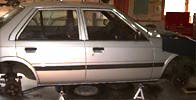EV Ingredients
 |
|---|
The first step is deciding what type of car to convert based upon driving expectations. I want an EV that is good for the commute to and from work, the grocery store, and other places around the Upper Valley. Our home is two miles south of Lebanon and most driving will be an easy 20 miles round trip.
My ideal choice is an older model compact car with a great body. The engine doesn't matter, of course, except for resale value, but in the salty road network of New Hampshire a used car with a great body isn't such an easy find.
I lucked out: a California resident attending school locally had a 1985 Mazda 626 for sale. It has a good body, no rust, and an engine that needs work.
 |
|---|
That takes care of the big piece, but there are many more ingredients for this recipe. Here's a typical list of additional components in an EV conversion:
- Electric Motor: 9" diameter, 16" long, 140lbs.
- Adapter Coupling between motor and transmission, may need spacers.
- Motor Mount(s).
- Motor Controller.
- Potbox: EV equivalent of accelerator, hooked to gas pedal and controller.
- Contactors: heavy duty relays/switches, 1-4 of them depending on the conversion.
- Safety Fuses.
- Circuit Breaker.
- DC-DC Converter: acts as the EV alternator converting 96-144vdc to 12vdc, feeds the car's normal power system (supplementing the 12volt battery) which powers lights, fans, radio, etc...
- Voltmeter.
- Ammeter: vital for monitoring the pulse and performance of your EV.
- Current Shunt: necessary for ammeter.
- Battery Fuel Guage: some options here, basically it measures the status of your system and projects how much juice you have left.
- Onboard Battery charger: for nightly refueling or topping off the batteries at work. Plugs into standard AC outlet.
- Battery Cable: heavy duty wiring for distributing the high power from batteries to controller to motor.
- Battery lugs, heat shrink tubing, vinyl hose, terminal covers, connectors: for safe, clean, installation.
- Vacuum pump: brake assist.
- Electric heater.
- Heat sinks and fans: for cooling controller, exhausting battery box, etc...
- Battery boxes: front and back.
- Various mounting boards, brackets, and hardware.
- Manufacture's manual for car w/wiring diagram.
- Heavier duty springs/struts: to support additional vehicle weight.